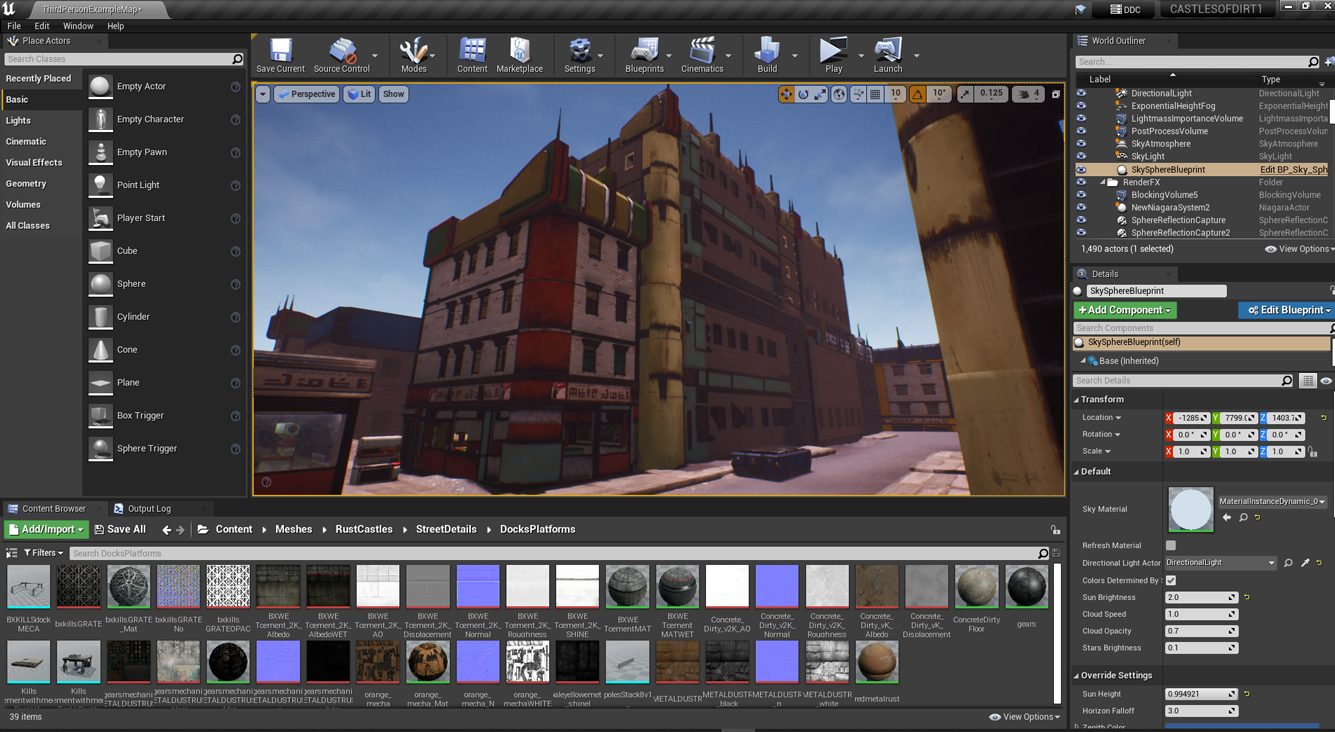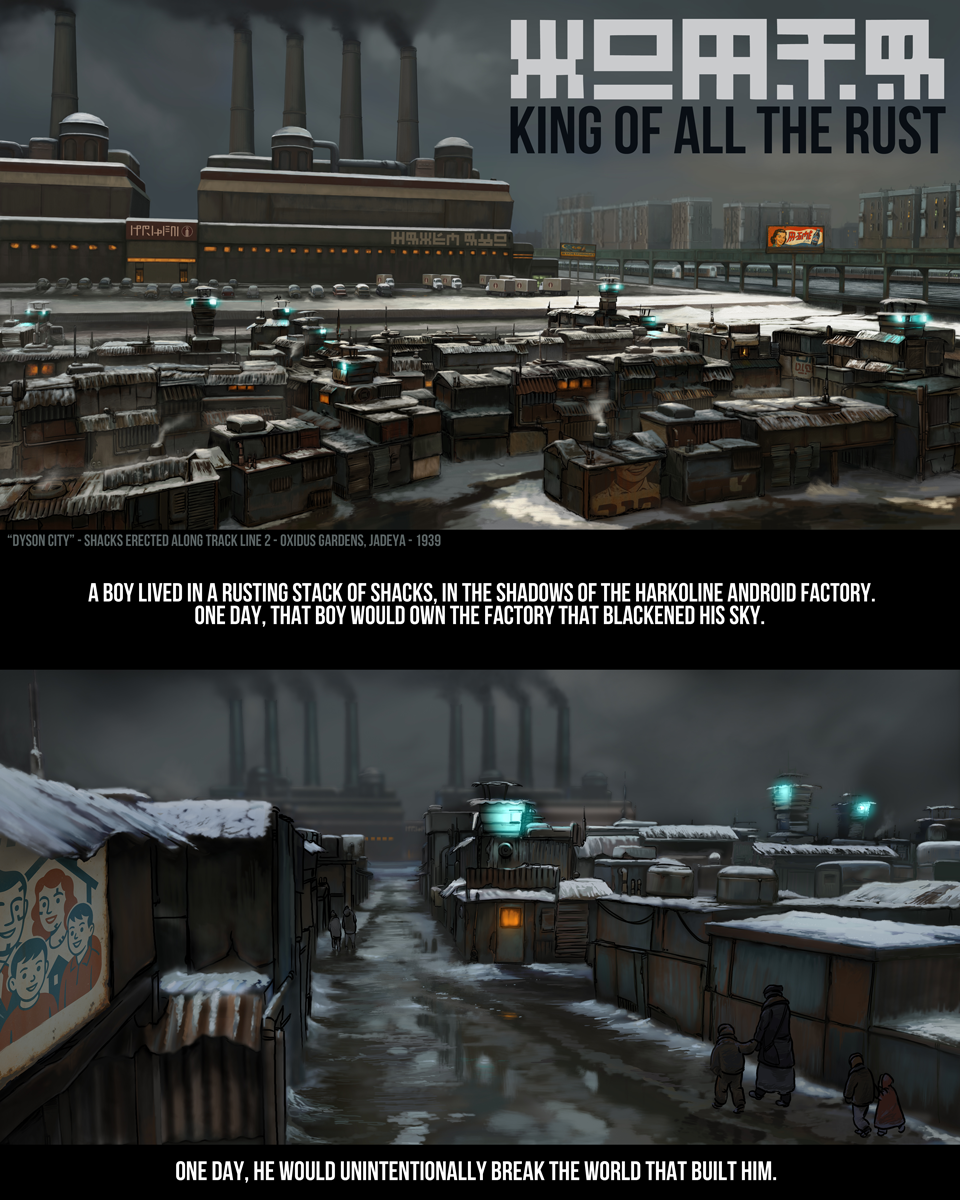KOATR
lAST UPDATE:
KING OF ALL THE RUST

WHAT IS KING OF ALL THE RUST (KOATR)?
King of All the Rust (KOATR) began as the backstory for a video game world I was designing. As I explored further, it became clear that this was a rich, detailed, living world brimming with lore. From this deep exploration came character sketches, 3D props, and countless pages of notes.
Nearly two years later, I had fully constructed the overall story, but the ending remained vague. I knew where I needed to go, but the path was hazy. To resolve this, I began writing the entire story through the eyes of the main characters, in chronological order. What started as info-dumps and Wikipedia-style retellings of the characters’ lives turned into something I’m very happy with. Not only did this process help me craft a satisfying ending (or endings) to the story’s overall arc, but it also allowed me to fully understand my characters on a level I hadn’t until now.
WHAT’S THE STORY ABOUT?
At its core, King of All the Rust is set in an alternate version of old New York, a place that feels both familiar and slightly off. The story centers on Levon Jovayas, a former industrial giant whose ambition led to disaster, and Radio Villajeros, a young girl from a poor neighborhood shaped by loss and the hope of something better. Both are pulled toward a sentient wormhole, drawn by its strange promise.
Levon is chasing time itself, hoping to hold onto something already slipping away. Radio seeks a glimpse of what was, reaching for something she was never ready to lose.
But the wormhole’s power doesn’t come free.
The question remains: can time, and by extension, reality, be tampered with, rewritten, or must they confront the ghosts it leaves behind?
Ultimately, King of All the Rust is envisioned as an animated series, bringing its intricate world and characters to life.
THE BEGINNING

3D WORLD BUILDING LEADS TO THE BIRTH OF KING OF ALL THE RUST
In late 2021, I decided to try my hand at the Unreal Engine. Creating fully detailed 2D worlds through drawings has always been compelling to me, but the idea of transforming those concepts into interactive 3D environments that one can explore in real time fascinates me. During some downtime, I downloaded the Unreal Engine. When I opened the program, I was greeted by a blank template and a wide array of tools.
Being a huge fan of open-world sandbox games, I knew I wanted to create something similar. Staring at the blank canvas, my mind raced with ideas for the kind of world I wanted my player character to inhabit. As a fan of Hip-Hop and its early roots, there was only one world I would truly enjoy building and exploring: the old South Bronx, as it appeared in the late 1960s and early 1970s, right on the cusp of the birth of Hip-Hop.

When my world was complete, it would be as close to a time machine as I could create. A world that could transport me back to that pivotal era in history cherished by lovers of Hip-Hop. However, the very first roadblock in creating this world was the lack of visual resources needed for a one-to-one recreation of the old South Bronx. While Google Maps could provide the layout of the streets as they once were, the gritty and rugged New York of that time had long since vanished. The world I wanted to capture existed only in fragments, in snippets from documentaries and still photographs that offered incomplete glimpses of its essence.
Taking inspiration from something I learned through Hip-Hop where copying another’s work was forbidden “don’t bite!” Instead, take what exists, flip it, and make it your own. My game world could never truly be the Bronx, but it could become The Larks, a neighborhood in A city-state called Jadeya, on a planet named Aeris. This marked the beginning of a world that would serve as the foundation and backdrop for the characters and story in King of All the Rust.

In researching my game world, I watched every documentary I could find online about that era in New York. I discovered many excellent films, such as 80 Blocks from Tiffany’s and Flyin’ Cut Sleeves. My first introduction to the Bronx, however, came through the movie Beat Street in 1985. I managed to record it on video, and after countless viewings, I began to focus on the background, the tags, the buildings, the desolation, and the debris. Something about that place resonated deeply with me, though I didn’t fully understand why at the time.
The conditions of the Bronx during Hip-Hop’s early days reminded me of Lima during my time there. That parallel sparked something within me. I knew I had to build this world.

As I continued working on the game, I created a player character to experiment with tutorials on movement and other player actions. The character was built in Blender, with textures designed in Photoshop. Initially, I aimed for a human character, but after being unsatisfied with how the face turned out, I pivoted and transformed him into a robot. His clothing design was heavily influenced by the documentaries I was watching at the time, particularly those about the Savage Skulls, a street gang from the days just before Hip-Hop’s emergence.

I had the player character up and running, and the world was beginning to take shape, but it all still needed a story. I knew my main character was an orphaned android, once belonging to someone who had suddenly vanished. In the aftermath of their disappearance, the boy android was taken in by street gangs, adapting surprisingly well to their harsh environment.
But the lingering question remained: what was the orphaned android’s world like before it collapsed? what was it like after?
Exploring these questions led me to uncover the world of King of All the Rust.

a page from my graphic novel – another way to bring KOATR to life.


